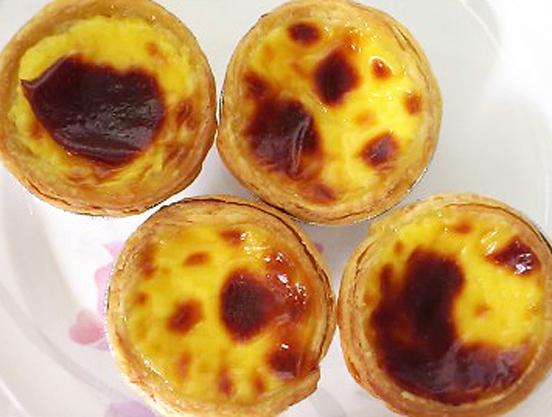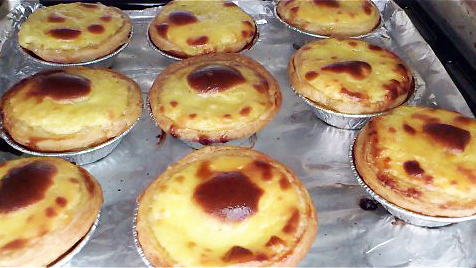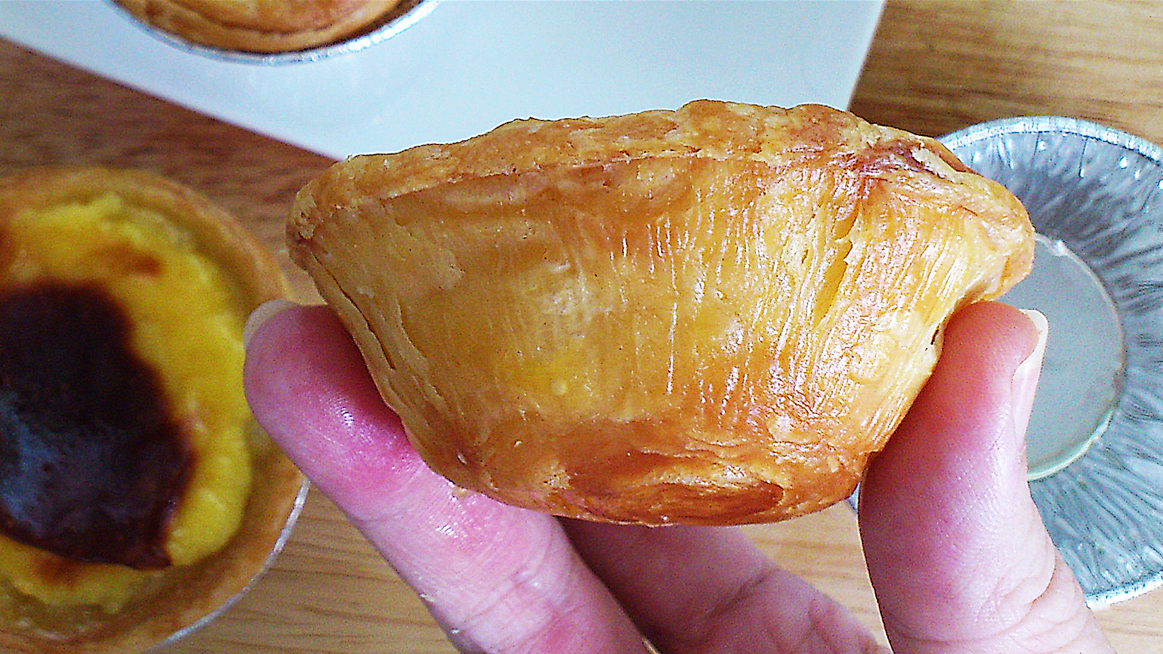Portuguese Egg Tarts

Portuguese egg tarts must be baked in a very hot oven, at about 250°C, to get their signature burn marks. At that temperature, shortcrust pastry would be incinerated. That’s why Portuguese egg tarts are made with puff pastry, which needs a high temperature to puff up.
High heat isn’t the only condition for creating burn marks. There must also be enough milk in the custard mixture.
Milk forms a film of protein when heated. The custard has to form the protein film. Why? Because it’s this film that’s burnt, not sugar or custard. Not enough milk means no film because there isn’t enough protein. No film means no burn marks even at 250°C, at least not before the pastry’s burnt.
A lot of people think PETs’ burnt splodges are bits of caramelized sugar. But sugar, or rather sucrose, turns black only when it hits at least 210°C. At that temperature, puff pastry would turn black too. Milk proteins, OTOH, brown at a much lower temperature. That’s why it’s burnt when the pastry and sugar aren’t.
The surface of the custard filling is shiny. The shine is due to melted sugar which separates from the custard mixture when heated. It then bubbles up to the top, giving the custard its shiny look.
Separated sugar’s a good thing except not all of it finds its way up if there’s a lot. Some of it may sink to the bottom of the tart and turn the pastry soggy.
How to tackle the problem? By controlling the amount of sugar that separates from the custard mixture. How? With cornflour.
Cornflour stabilizes the custard, and reduces the amount of sugar separated.
Activating the binding quality of cornflour requires the custard mixture to be heated to the right consistency.
If the consistency is too thick, the custard turns into scrambled eggs when it’s baked.
If the consistency is slightly too thin, the custard allows too much sugar to separate when baked, turning the pastry soggy.
If the custard is really very watery, it boils when it’s heated in the oven. Boiling custard bubbles furiously and spills out out its shell.
Your tarts will be perfect only if the custard is not too thick and not too thin.
Even store-bought tarts may have a sunken top. Just look at the PET photos online. Lord Stow’s, the gold standard, are picture perfect only some of the time, i.e. when there’s a press review! How to stop the custard from sinking as it cools down so that the top stays level? Again by stabilizing it with cornflour.
Making PETs isn’t difficult once you understand the science behind the tarts. You just have to get the custard to the right consistency.

Macau Style Portuguese Egg Tarts
Video
Ingredients
- 60 g dairy cream around 35% fat
- 60 g sugar
- 30 g egg yolks
- 260 g full-fat fresh milk
- 1 tbsp cornflour
- ½ tsp vanilla extract
- 9 frozen puff pastry shells 7 x 3 cm
Instructions
- Whisk cream, sugar, yolks, milk and cornflour till smooth. Stir over medium-low heat till thick enough to coat pot thinly (or metal spoon if using non-stick pot). Place pot in water-bath. Add vanilla extract. Stir till mixture is half-cool. Leave to cool completely.60 g dairy cream, 60 g sugar, 30 g egg yolks, 260 g full-fat fresh milk, 1 tbsp cornflour, ½ tsp vanilla extract
- Preheat oven to 250°C. Line baking tray with aluminium foil, shiny side up.
- When oven is ready, remove pastry shells from freezer. Place slightly apart on baking tray. Fill shells with custard to 5 mm from edge. Bake till crust is brown, and custard is burnt and just stops bubbling. This takes 30-35 minutes. Check every 10 minutes and rotate tray as necessary so that all tarts brown evenly.9 frozen puff pastry shells
- Remove tarts from oven to wire rack. Leave till cool. Serve within a few hours whilst pastry is crisp.
- Leftovers should be unmoulded before pastry softens, then refrigerated uncovered (make sure there isn’t any funky odour in your fridge). Reheat tarts on foil lined baking tray at 200°C. Pastry would turn soggy after 5 minutes, then crisp up nicely after another 5 minutes or so. Custard would be creamy and smooth but a bit sunken.